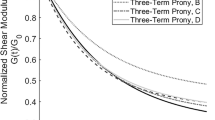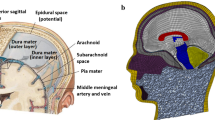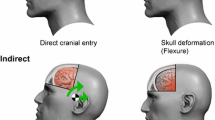Abstract
Upon impingement of blast waves on the head, stress waves generated at the interface of the skull are transferred into the cranium and the brain tissue and may cause mild to severe blast traumatic brain injury. The intensity of the shock front, defined by the blast overpressure (BoP), that is, the blast-induced peak static overpressure, significantly affects head kinematics as well as the tissue responses of the brain. While evaluation of global linear and rotational accelerations may be feasible, an experimental determination of dynamic responses of the brain in terms of intracranial pressure (ICP), maximum shear stress (MSS), and maximum principal strain (MPS) is almost impossible. The main objective of this study is to investigate possible correlations between head accelerations and the brain’s ICP, MSS, and MPS. To this end, three different blasts were simulated by modeling the detonation of 70, 200, and 500 g of TNT at a fixed distance from the head, corresponding to peak BoPs of 0.52, 1.2, and 2 MPa, respectively. A nonlinear multi-material finite element algorithm was implemented in the LS-DYNA explicit solver. Fluid–solid interaction between the blast waves and head was modeled using a penalty-based method. Strong correlations were found between the brain’s dynamic responses and both global linear and rotational accelerations at different blast intensities (\(R^{2 }\ge \) 98%), implying that global kinematic parameters of the head might be strong predictors of brain tissue biomechanical parameters.






Similar content being viewed by others
References
Chafi, M., Karami, G., Ziejewski, M.: Biomechanical assessment of brain dynamic responses due to blast pressure waves. Ann. Biomed. Eng. 38(2), 490–504 (2010). doi:10.1007/s10439-009-9813-z
Taylor, P.A., Ludwigsen, J.S., Ford, C.C.: Investigation of blast-induced traumatic brain injury. Brain Inj. 28(7), 879–895 (2014). doi:10.3109/02699052.2014.888478
Sarvghad-Moghaddam, H., Rezaei, A., Karami, G., Ziejewski, M.: Computational investigation of brain neurotrauma biomechanics under blast. J. Neurotrauma 31(12), A123–A123 (2014)
Mao, H., Zhang, L., Yang, K.H., King, A.I.: Application of a finite element model of the brain to study traumatic brain injury mechanisms in the rat. Stapp Car Crash J. 50, 583–600 (2006)
Moss, W.C., King, M.J., Blackman, E.G.: Skull flexure from blast waves: a mechanism for brain injury with implications for helmet design. Phys. Rev. Lett. 103(10), 108702 (2009). doi:10.1103/PhysRevLett.103.108702
Sarvghad-Moghaddam, H., Rezaei, A., Ziejewski, M., Karami, G.: Evaluation of brain tissue responses due to the underwash overpressure of helmet and faceshield under blast loading. Int. J. Numer. Methods Biomed. Eng. e02782 (2016). doi:10.1002/cnm.2782
Panzer, M.B., Myers, B.S., Capehart, B.P., Bass, C.R.: Development of a finite element model for blast brain injury and the effects of CSF cavitation. Ann. Biomed. Eng. 40(7), 1530–1544 (2012). doi:10.1007/s10439-012-0519-2
Shridharani, J., Wood, G.W., Panzer, M.B., Capehart, B.P., Nyein, M., Radovitzky, R.A., Bass, C.R.D.: Porcine head response to blast. Front. Neurol. 3, 70 (2012). doi:10.3389/fneur.2012.00070
Mao, H., Unnikrishnan, G., Rakesh, V., Reifman, J.: Untangling the effect of head acceleration on brain responses to blast waves. J. Biomech. Eng. 137(12), 124502 (2015). doi:10.1115/1.4031765
Chandra, N., Ganpule, S., Kleinschmit, N.N., Feng, R., Holmberg, A.D., Sundaramurthy, A., Selvan, V., Alai, A.: Evolution of blast wave profiles in simulated air blasts: experiment and computational modeling. Shock Waves 22(5), 403–415 (2012). doi:10.1007/s00193-012-0399-2
King, A.I., Yang, K.H., Zhang, L., Hardy, W., Viano, D.C.: Is head injury caused by linear or angular acceleration. In: IRCOBI Conference, pp. 1–12 (2003)
Zhang, L., Yang, K.H., King, A.I.: A proposed injury threshold for mild traumatic brain injury. J. Biomech. Eng. 126(2), 226–236 (2004). doi:10.1115/1.1691446
Horgan, T.J., Gilchrist, M.D.: The creation of three-dimensional finite element models for simulating head impact biomechanics. Int. J. Crashworthiness 8(4), 353–366 (2003). doi:10.1533/ijcr.2003.0243
Sarvghad-Moghaddam, H., Jazi, M.S., Rezaei, A., Karami, G., Ziejewski, M.: Examination of the protective roles of helmet/faceshield and directionality for human head under blast waves. Comput. Methods Biomech. Biomed. Eng. 18(16), 1846–1855 (2015). doi:10.1080/10255842.2014.977878
Chafi, M.S.: Biomechanical analysis of blast-induced traumatic brain injury using multiscale brain modeling. PhD Thesis, North Dakota State University (2009)
Nahum, A.M., Smith, R.: Intracranial pressure dynamics during head impact. Paper presented at: proceedings of 21st stapp car crash conference, New Orleans, LA, USA. SAE paper no. 770922. Society of Automotive Engineering, Warrendale, PA (1977). doi:10.4271/770922
HyperMesh, A.: 11.0. Altair Engineering. Inc., Troy, MI, USA
Sarvghad-Moghaddam, H.: Computational biomechanics of blast-induced traumatic brain injury: role of loading directionality, head protection, and blast flow mechanics. PhD Thesis, North Dakota State University (2015)
Zhang, L., Makwana, R., Sharma, S.: Brain response to primary blast wave using validated finite element models of human head and advanced combat helmet. Front. Neurol. 4, 88 (2013). doi:10.3389/fneur.2013.00088
Mendis, K., Stalnaker, R., Advani, S.: A constitutive relationship for large deformation finite element modeling of brain tissue. J. Biomech. Eng. 117(3), 279–285 (1995). doi:10.1115/1.2794182
Sarvghad-Moghaddam, H., Karami, G., Ziejewski, M.: Examination of the blast-induced underwash effect on a helmeted head and the response of the brain. Paper presented at the 17th U.S. National Congress on Theoretical and Applied Mechanics, Michigan State University, East Lansing, MI, June 2014
Hallquist, J.O.: LS-DYNA Keyword User’s Manual, vol. 970. Livermore Software Technology Corporation, Livermore (2007)
Sarvghad-Moghaddam, H., Rezaei, A., Ziejewski, M., Karami, G.: A comparative study on the protection efficiency of combat helmets against ballistic impacts and blast waves. J. Head Trauma Rehabil. 30(3), 66 (2015)
Sarvghad-Moghaddam, H., Rezaei, A., Ziejewski, M., Karami, G.: The influence of directionality on correlating kinematical severity to tissue level injury of the human head. J. Head Trauma Rehabil. 3, E67 (2015)
Salimi Jazi, M., Rezaei, A., Azarmi, F., Ziejewski, M., Karami, G.: Computational biomechanics of human brain with and without the inclusion of the body under different blast orientation. Comput. Methods Biomech. Biomed. Eng. 19(9), 1019–31 (2016). doi:10.1080/10255842.2015.1088525
Post, A., Oeur, A., Hoshizaki, B., Gilchrist, M.D.: Examination of the relationship between peak linear and angular accelerations to brain deformation metrics in hockey helmet impacts. Comput. Methods Biomech. Biomed. Eng. 16(5), 511–519 (2013). doi:10.1080/10255842.2011.627559
Sabet, A.A., Christoforou, E., Zatlin, B., Genin, G.M., Bayly, P.V.: Deformation of the human brain induced by mild angular head acceleration. J. Biomech. 41(2), 307–315 (2008). doi:10.1016/j.jbiomech.2007.09.016
Hernandez, F., Shull, P.B., Camarillo, D.B.: Evaluation of a laboratory model of human head impact biomechanics. J. Biomech. 48(12), 3469–3477 (2015). doi:10.1016/j.jbiomech.2015.05.034
Leonardi, A.D.C., Bir, C.A., Ritzel, D.V., VandeVord, P.J.: Intracranial pressure increases during exposure to a shock wave. J. Neurotrauma 28(1), 85–94 (2011). doi:10.1089/neu.2010.1324
Sarvghad-Moghaddam, H., Karami, G., Ziejewski, M.: The effects of directionality of blunt impacts on mechanical response of the brain. In: ASME 2014 International Mechanical Engineering Congress and Exposition, Montreal, Canada, November 2014, p. 3–13. American Society of Mechanical Engineers (2014). doi:10.1115/IMECE2014-39338
Zhang, L., Yang, K.H., King, A.I.: Comparison of brain responses between frontal and lateral impacts by finite element modeling. J. Neurotrauma 18(1), 21–30 (2004). doi:10.1089/089771501750055749
Ganpule, S., Alai, A., Plougonven, E., Chandra, N.: Mechanics of blast loading on the head models in the study of traumatic brain injury using experimental and computational approaches. Biomech. Model. Mechanobiol. 12(3), 511–531 (2013). doi:10.1007/s10237-012-0421-8
Author information
Authors and Affiliations
Corresponding author
Additional information
Communicated by O. Petel and S. Ouellet.
Rights and permissions
About this article
Cite this article
Sarvghad-Moghaddam, H., Rezaei, A., Ziejewski, M. et al. Correlative analysis of head kinematics and brain’s tissue response: a computational approach toward understanding the mechanisms of blast TBI. Shock Waves 27, 919–927 (2017). https://doi.org/10.1007/s00193-017-0749-1
Received:
Revised:
Accepted:
Published:
Issue Date:
DOI: https://doi.org/10.1007/s00193-017-0749-1




